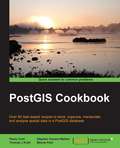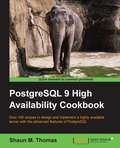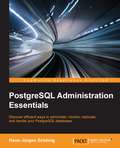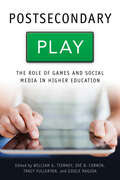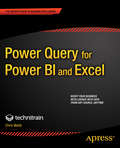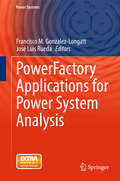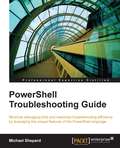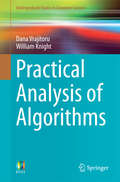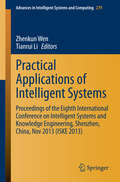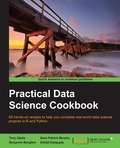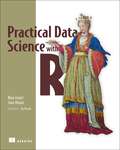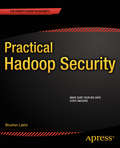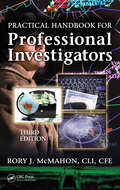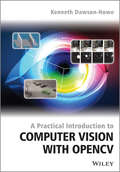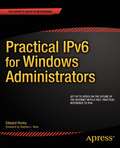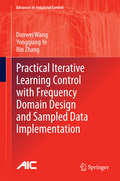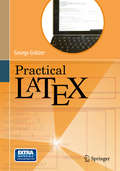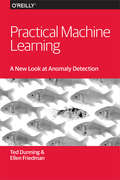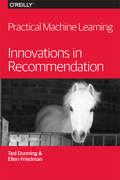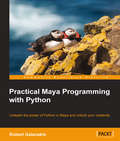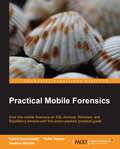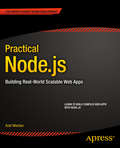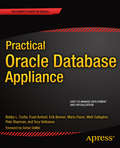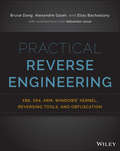- Table View
- List View
PostGIS Cookbook
by Bborie Park Paolo Corti Stephen Vincent Mather Thomas J. KraftAn easy-to-use guide, full of hands-on recipes for manipulating spatial data in a PostGIS database. Each topic is explained and placed in context, and for the more inquisitive, there are more details of the concepts used. If you are a web developer or a software architect, especially in location-based companies, and want to expand the range of techniques you are using with PostGIS, then this book is for you. You should have some prior experience with PostgreSQL database and spatial concepts.
PostgreSQL 9 High Availability Cookbook
by Shaun M. ThomasA comprehensive series of dependable recipes to design, build, and implement a PostgreSQL server architecture free of common pitfalls that can operate for years to come. Each chapter is packed with instructions and examples to simplify even highly complex database operations. If you are a PostgreSQL DBA working on Linux systems who want a database that never gives up, this book is for you. If you've ever experienced a database outage, restored from a backup, spent hours trying to repair a malfunctioning cluster, or simply want to guarantee system stability, this book is definitely for you.
PostgreSQL Administration Essentials
by Hans-Jurgen SchonigIf you are a database administrator who needs to get to grips with PostgreSQL quickly and efficiently, then this book is for you. This book will also be highly beneficial if you are a project leader or a developer who is interested in knowing more about database systems or bottleneck detection, as it will enable you to work more closely and cooperatively with your administrators.
Postsecondary Play: The Role of Games and Social Media in Higher Education (Tech.edu: A Hopkins Series on Education and Technology)
by William G. Tierney, Zoë B. Corwin, Tracy Fullerton and Gisele RagusaGames and social media can improve college access, attract and support students, and boost rates of completion.The college application process—which entails multiple forms, essays, test scores, and deadlines—can be intimidating. For students without substantial school and family support, the complexity of this process can become a barrier to access. William G. Tierney, Tracy Fullerton, and their teams at the University of Southern California approach this challenge innovatively. Using the tools of online games and social media, they have developed ways to make applying for college much less intimidating.While the vast majority of college students use social media and gaming in their everyday lives, colleges and universities have been slow to recognize and harness the power of either. Postsecondary Play explores the significance of games and social media in higher education, and particularly how they can be used to attract, retain, educate, and socialize students.Tierney, a past president of the American Educational Research Association, has gathered some of the best research on the emerging role of games and social media in the classroom and how these tools can boost student confidence and increase college access. Scholars writing from a wide variety of disciplines—college access, social media, game studies, and learning sciences—provide concrete examples to illustrate the new and complex ways in which students learn in response to social media and games. Tierney and the contributors find that, although games can be powerful tools for encouraging underserved students, quality game design and mastering the concept of play—the ability to develop skills while engaging in the game—are essential in the effective use of serious games in teaching and learning.Summarizing a decade of research in game design and learning, Postsecondary Play will appeal to higher education scholars and students of learning, online gaming, education, and the media.
Power Query for Power BI and Excel
by Chris WebbPower Query for Power BI and Excel is a book for people who are tired of copying and pasting data into Excel worksheets. Power Query, part of the Microsoft Power BI suite, is a tool that automates the process of getting data into Excel and will save you hours of dull, repetitive, and error-prone work! Power Query makes it easy to extract data from many different data sources, filter that data, aggregate it, clean it and perform calculations on it, finally loading that data into either your worksheet or directly into the new Excel 2013 Data Model used by Power Pivot. This concise, practical book provides a complete guide to Power Query and how to use it to solve all of your Excel data-loading problems. Power Query for Power BI and Excel goes well beyond the surface of what Power Query can do. The book goes deep into the underlying M language, showing you how to do amazing things that aren't going to be possible from just the GUI interface that is covered in most other books. You'll have full command of the GUI, and you'll be able to drop into the M language to go beyond what the GUI provides. The depth in this book makes it a must-have item for anyone who is pushing Power BI and Excel to their limits in the pursuit of business intelligence from data analysis. Teaches the basics of using Power Query to load data into Excel Helps you solve common, data-related problems with Power Query Shows how to write your own solutions in the powerful M language What you'll learn Import data from sources including relational databases, text files, web pages, and Excel workbooks. Import from more exotic sources such as Facebook, Windows Azure Marketplace, Wikipedia, and OData feeds within and outside your organization. Build repeatable processes to filter, clean, aggregate, and transform your data. Load your data into an Excel table or directly into the Excel 2013 Data Model. Write complex expressions in Power Query's M expression language. Share queries and their data with other users in your organization. Position your data for further analysis using Power View, Power Map, Power Pivot, and the rest of Microsoft's Power BI suite. Who this book is for Power Query for Power BI and Excel is aimed at serious Excel and Power BI users who need to import data into a worksheet. Whether you are an analyst, report writer, business intelligence consultant, or just "that guy" whose job it is to prepare the monthly sales dashboard, you'll learn how Power Query can make your life easier. Power Query for Power BI and Excel is especially important for Excel and BI power users who want to work directly in the M language that underlies all of Power Query's functionality. Table of Contents Power Query and When to Use It Data Sources Transformations Tables and the Excel Data Model Expressions in the M Language Multiple Data Sources Power BI and Sharing Common Problems Solved
PowerFactory Applications for Power System Analysis
by Francisco M. Gonzalez-Longatt José Luis RuedaThis book presents a comprehensive set of guidelines and applications of DIgSILENT PowerFactory, an advanced power system simulation software package, for different types of power systems studies. Written by specialists in the field, it combines expertise and years of experience in the use of DIgSILENT PowerFactory with a deep understanding of power systems analysis. These complementary approaches therefore provide a fresh perspective on how to model, simulate and analyse power systems. It presents methodological approaches for modelling of system components, including both classical and non-conventional devices used in generation, transmission and distribution systems, discussing relevant assumptions and implications on performance assessment. This background is complemented with several guidelines for advanced use of DSL and DPL languages as well as for interfacing with other software packages, which is of great value for creating and performing different types of steady-state and dynamic performance simulation analysis. All employed test case studies are provided as supporting material to the reader to ease recreation of all examples presented in the book as well as to facilitate their use in other cases related to planning and operation studies. Providing an invaluable resource for the formal instruction of power system undergraduate/postgraduate students, this book is also a useful reference for engineers working in power system operation and planning.
PowerShell Troubleshooting Guide
by Michael ShepardWindows PowerShell provides an amazing platform for administrative scripting and automation. Understanding the PowerShell language will enable you to spend less time troubleshooting and be more effective when debugging is required. PowerShell also includes several avenues to provide feedback from your code that will make your troubleshooting and debugging time more profitable.</p><p>Improved coding practices combined with useful diagnostic information can lead to results quickly. This book starts with background information on the purposes of automation and PowerShell's entrance into Microsoft's automation strategy, and also answers the question of whether scripting (and specifically PowerShell scripting) is essentially different than traditional programming. A brief overview of the main features of the PowerShell language along with examples is provided. Focus is placed on proper script design and use of PowerShell features in an attempt to reduce the need for troubleshooting.
Practical Analysis of Algorithms
by Dana Vrajitoru William KnightThis book introduces the essential concepts of algorithm analysis required by core undergraduate and graduate computer science courses, in addition to providing a review of the fundamental mathematical notions necessary to understand these concepts. Features: includes numerous fully-worked examples and step-by-step proofs, assuming no strong mathematical background; describes the foundation of the analysis of algorithms theory in terms of the big-Oh, Omega, and Theta notations; examines recurrence relations; discusses the concepts of basic operation, traditional loop counting, and best case and worst case complexities; reviews various algorithms of a probabilistic nature, and uses elements of probability theory to compute the average complexity of algorithms such as Quicksort; introduces a variety of classical finite graph algorithms, together with an analysis of their complexity; provides an appendix on probability theory, reviewing the major definitions and theorems used in the book.
Practical Applications of Intelligent Systems
by Zhenkun Wen Tianrui Li"Practical Applications of Intelligent Systems" presents selected papers from the 2013 International Conference on Intelligent Systems and Knowledge Engineering (ISKE2013). The aim of this conference is to bring together experts from different expertise areas to discuss the state-of-the-art in Intelligent Systems and Knowledge Engineering, and to present new research results and perspectives on future development. The topics in this volume include, but are not limited to: Intelligent Game, Intelligent Multimedia, Business Intelligence, Intelligent Bioinformatics Systems, Intelligent Healthcare Systems, User Interfaces and Human Computer Interaction, Knowledge-based Software Engineering, Social Issues of Knowledge Engineering, etc. The proceedings are benefit for both researchers and practitioners who want to learn more about the current practice, experience and promising new ideas in the broad area of intelligent systems and knowledge engineering. Dr. Zhenkun Wen is a Professor at the College of Computer and Software Engineering, Shenzhen University, China. Dr. Tianrui Li is a Professor at the School of Information Science and Technology, Southwest Jiaotong University, Xi'an, China.
Practical Data Science Cookbook
by Tony Ojeda Sean Patrick MurphyIf you are an aspiring data scientist who wants to learn data science and numerical programming concepts through hands-on, real-world project examples, this is the book for you. Whether you are brand new to data science or you are a seasoned expert, you will benefit from learning about the structure of data science projects, the steps in the data science pipeline, and the programming examples presented in this book. Since the book is formatted to walk you through the projects with examples and explanations along the way, no prior programming experience is required.
Practical Data Science with R
by Nina Zumel John Mount"Practical Data Science with R" lives up to its name. It explains basic principles without the theoretical mumbo-jumbo and jumps right to the real use cases you'll face as you collect, curate, and analyze the data crucial to the success of your business. You'll apply the R programming language and statistical analysis techniques to carefully explained examples based in marketing, business intelligence, and decision support.
Practical Hadoop Security
by Bhushan LakhePractical Hadoop Security is an excellent resource for administrators planning a production Hadoopydeployment whoywant to secure their Hadoop clusters. yA detailed guide to theysecurity options and configurationywithin Hadoop itself, author BhushanyLakhe takes you through a comprehensive studyyof how to implement defined security within a Hadoop cluster in a hands-on way. You will start withya detailed overview of all the security options available for Hadoop, includingypopular extensions like Kerberos and OpenSSH, and then delve into a hands-on implementation of user security (with illustrated code samples)ywith both in-the-box features and with security extensions implemented by leading vendors. No security system is complete without a monitoring and tracing facility, so Practical Hadoop Security next steps you throughyaudit logging and monitoring technologies for Hadoop, as well as ready to useyimplementation and configuration examples--again with illustrated code samples. The book concludes with the most important aspect of Hadoop security - encryption. Both types of encryptions, for data in transit and data at rest, are discussed at length with leading open source projects that integrate directly with Hadoop at no licensing cost. y Practical Hadoop Security: Explains importance of security, auditing and encryption within a Hadoop installation Describes how the leading players have incorporated these features within their Hadoop distributions and provided extensions Demonstrates how to set up and use these features to your benefit and make your Hadoop installation secure without impacting performance or ease of use"
Practical Handbook for Professional Investigators
by Rory J. McMahon CLI CFE Randy DicksonThe third edition of this popular volume continues to supply an up-to-date, nuts-and-bolts learning tool for students and an everyday reference for investigative professionals at all levels. More relevant than ever, this edition adds two new chapters on death and terrorism investigations and several new sections, including insurance fraud, fire and arson investigation; indicators of online marital infidelity; obtaining governmental reports; service of subpoenas for witnesses in federal courts; the Rules of Professional Conduct; niche markets in the investigative industry; and managing and marketing an investigative practice.
A Practical Introduction to Computer Vision with OpenCV
by Kenneth Dawson-HoweExplains the theory behind basic computer vision and provides a bridge from the theory to practical implementation using the industry standard OpenCV librariesComputer Vision is a rapidly expanding area and it is becoming progressively easier for developers to make use of this field due to the ready availability of high quality libraries (such as OpenCV 2). This text is intended to facilitate the practical use of computer vision with the goal being to bridge the gap between the theory and the practical implementation of computer vision. The book will explain how to use the relevant OpenCV library routines and will be accompanied by a full working program including the code snippets from the text. This textbook is a heavily illustrated, practical introduction to an exciting field, the applications of which are becoming almost ubiquitous. We are now surrounded by cameras, for example cameras on computers & tablets/ cameras built into our mobile phones/ cameras in games consoles; cameras imaging difficult modalities (such as ultrasound, X-ray, MRI) in hospitals, and surveillance cameras. This book is concerned with helping the next generation of computer developers to make use of all these images in order to develop systems which are more intuitive and interact with us in more intelligent ways. Explains the theory behind basic computer vision and provides a bridge from the theory to practical implementation using the industry standard OpenCV librariesOffers an introduction to computer vision, with enough theory to make clear how the various algorithms work but with an emphasis on practical programming issuesProvides enough material for a one semester course in computer vision at senior undergraduate and Masters levels Includes the basics of cameras and images and image processing to remove noise, before moving on to topics such as image histogramming; binary imaging; video processing to detect and model moving objects; geometric operations & camera models; edge detection; features detection; recognition in imagesContains a large number of vision application problems to provide students with the opportunity to solve real problems. Images or videos for these problems are provided in the resources associated with this book which include an enhanced eBook
Practical IPv6 for Windows Administrators
by Edward HorleyPractical IPv6 for Windows Administrators is a handy guide to implementing IPv6 in a Microsoft Windows environment. This is the book you need if you are a Microsoft Windows Administrator confronted with IPv6 and in need of a quick resource to get up and going. The book covers the current state of IPv6 and its support in Microsoft Windows. It provides best-practices and other guidance toward successful implementation. This book is especially written with the goal of translating your current expertise in IPv4 into the new realm of IPv6. Special attention is given to dual-stack configurations, helping you to run IPv4 and IPv6 side-by-side and support both protocol versions during a transition period. Practical IPv6 for Windows Administrators is also a fast reference you can look at to get something done quickly. It covers IPv6 addressing, management of IPv6 from Powershell, Advanced Firewall configuration, and use of IPv6 in Hyper-V and virtual networking environments. You'll find practical examples showing how IPv6 integrates with all the standard tools you use for IPv4 today, tools like DNS and DHCP. You'll also find insider knowledge on IPv6 that can help avert stumbling points on the road to deployment. Provides a quick path from IPv4 expertise to IPv6 implementation Gives best-practices specific to Windows on IPv6 and dual stack networks Is chock full of practical examples showing how to manage IPv6 on Windows What you'll learn Understand IPv6 addressing and how it works in Windows Implement best practices involving IPv6 for Exchange, IIS, and SharePoint Manage IPv6 from PowerShell and the Windows Advanced Firewall Deploy IPv6 from virtual networking environments such as in Hyper-V Integrate IPv6 into Windows Server functions such as DNS, DHC, and Active Directory Take advantage of IPv6 transition technologies that are supported in Windows Who this book is for Practical IPv6 for Windows Administrators is ideal for those working with Microsoft Windows operating systems who need to implement IPv6. The book is is designed for Microsoft Windows Administrators, but is also useful for developers, network engineers, and storage administrators who are involved in the architecture of Windows solutions. Table of Contents IPv6: The Big Picture IPv6 Support in Windows IPv6 Addressing IPv6 Best Practices in Windows IPv6 and PowerShell IPv6 and Advanced Firewall IPv6 in Hyper-V and Virtual Networking IPv6 and DNS IPv6 and DHCP Miscellaneous IPv6 Items
Practical Iterative Learning Control with Frequency Domain Design and Sampled Data Implementation
by Danwei Wang Yongqiang Ye Bin ZhangThis book is on the iterative learning control (ILC) with focus on the design and implementation. We approach the ILC design based on the frequency domain analysis and address the ILC implementation based on the sampled data methods. This is the first book of ILC from frequency domain and sampled data methodologies. The frequency domain design methods offer ILC users insights to the convergence performance which is of practical benefits. This book presents a comprehensive framework with various methodologies to ensure the learnable bandwidth in the ILC system to be set with a balance between learning performance and learning stability. The sampled data implementation ensures effective execution of ILC in practical dynamic systems. The presented sampled data ILC methods also ensure the balance of performance and stability of learning process. Furthermore, the presented theories and methodologies are tested with an ILC controlled robotic system. The experimental results show that the machines can work in much higher accuracy than a feedback control alone can offer. With the proposed ILC algorithms, it is possible that machines can work to their hardware design limits set by sensors and actuators. The target audience for this book includes scientists, engineers and practitioners involved in any systems with repetitive operations.
Practical LaTeX
by George GrätzerPractical LaTeX covers the material that is needed for everyday LaTeX documents. This accessible manual is friendly, easy to read, and is designed to be as portable as LaTeX itself. A short chapter, Mission Impossible, introduces LaTeX documents and presentations. Read these 30 pages; you then should be able to compose your own work in LaTeX The remainder of the book delves deeper into the topics outlined in Mission Impossible while avoiding technical subjects. Chapters on presentations and illustrations are a highlight, as is the introduction of LaTeX on an iPad. Students, faculty, and professionals in the worlds of mathematics and technology will benefit greatly from this new, practical introduction to LaTeX. George Grätzer, author of More Math into LaTeX (now in its 4th edition) and First Steps in LaTeX, has been a LaTeX guru for over a quarter of century. From the reviews of More Math into LaTeX: ``There are several LaTeX guides, but this one wins hands down for the elegance of its approach and breadth of coverage. '' --Amazon. com, Best of 2000, Editors Choice ``A very helpful and useful tool for all scientists and engineers. '' --Review of Astronomical Tools``A novice reader will be able to learn the most essential features of LaTeX sufficient to begin typesetting papers within a few hours of time. . . An experienced TeX user, on the other hand, will find a systematic and detailed discussion of all LaTeX features, supporting software, and many other advanced technical issues. '' --Reports on Mathematical Physics
Practical Machine Learning: A New Look at Anomaly Detection
by Ellen Friedman Ted DunningFinding Data Anomalies You Didn't Know to Look ForAnomaly detection is the detective work of machine learning: finding the unusual, catching the fraud, discovering strange activity in large and complex datasets. But, unlike Sherlock Holmes, you may not know what the puzzle is, much less what "suspects" you're looking for. This O'Reilly report uses practical examples to explain how the underlying concepts of anomaly detection work.From banking security to natural sciences, medicine, and marketing, anomaly detection has many useful applications in this age of big data. And the search for anomalies will intensify once the Internet of Things spawns even more new types of data. The concepts described in this report will help you tackle anomaly detection in your own project.Use probabilistic models to predict what's normal and contrast that to what you observeSet an adaptive threshold to determine which data falls outside of the normal range, using the t-digest algorithmEstablish normal fluctuations in complex systems and signals (such as an EKG) with a more adaptive probablistic modelUse historical data to discover anomalies in sporadic event streams, such as web trafficLearn how to use deviations in expected behavior to trigger fraud alerts
Practical Machine Learning: A New Look at Anomaly Detection
by Ellen Friedman Ted DunningFinding Data Anomalies You Didn't Know to Look For. Anomaly detection is the detective work of machine learning: finding the unusual, catching the fraud, discovering strange activity in large and complex datasets. But, unlike Sherlock Holmes, you may not know what the puzzle is, much less what “suspects” you’re looking for. This O’Reilly report uses practical examples to explain how the underlying concepts of anomaly detection work.From banking security to natural sciences, medicine, and marketing, anomaly detection has many useful applications in this age of big data. And the search for anomalies will intensify once the Internet of Things spawns even more new types of data. The concepts described in this report will help you tackle anomaly detection in your own project. Use probabilistic models to predict what’s normal and contrast that to what you observe; Set an adaptive threshold to determine which data falls outside of the normal range, using the t-digest algorithm; Establish normal fluctuations in complex systems and signals (such as an EKG) with a more adaptive probablistic model; Use historical data to discover anomalies in sporadic event streams, such as web traffic; Learn how to use deviations in expected behavior to trigger fraud alerts.
Practical Machine Learning: Innovations in Recommendation
by Ted Dunning Ellen FriedmanBuilding a simple but powerful recommendation system is much easier than you think. Approachable for all levels of expertise, this report explains innovations that make machine learning practical for business production settings--and demonstrates how even a small-scale development team can design an effective large-scale recommendation system.Apache Mahout committers Ted Dunning and Ellen Friedman walk you through a design that relies on careful simplification. You'll learn how to collect the right data, analyze it with an algorithm from the Mahout library, and then easily deploy the recommender using search technology, such as Apache Solr or Elasticsearch. Powerful and effective, this efficient combination does learning offline and delivers rapid response recommendations in real time.Understand the tradeoffs between simple and complex recommendersCollect user data that tracks user actions--rather than their ratingsPredict what a user wants based on behavior by others, using Mahoutfor co-occurrence analysisUse search technology to offer recommendations in real time, complete with item metadataWatch the recommender in action with a music service exampleImprove your recommender with dithering, multimodal recommendation, and other techniques
Practical Maya Programming with Python
by Robert Galanakis"Practical Maya Programming with Python" is a practical tutorial packed with plenty of examples and sample projects which guides you through building reusable, independent modules and handling unexpected errors. If you are a developer looking to build a powerful system using Python and Maya's capabilities, then this book is for you. Practical Maya Programming with Python is perfect for intermediate users with basic experience in Python and Maya who want to better their knowledge and skills.
Practical Mobile Forensics
by Satish Bommisetty Heather Mahalik Rohit TammaThe book is an easy-to-follow guide with clear instructions on various mobile forensic techniques. The chapters and the topics within are structured for a smooth learning curve, which will swiftly empower you to master mobile forensics. If you are a budding forensic analyst, consultant, engineer, or a forensic professional wanting to expand your skillset, this is the book for you. The book will also be beneficial to those with an interest in mobile forensics or wanting to find data lost on mobile devices. It will be helpful to be familiar with forensics in general but no prior experience is required to follow this book.
Practical Node.js
by Azat MardanPractical Node. js is your step-by-step guide to learning how to build a wide range of scalable real-world web applications using a professional development toolkit. Node. js is an innovative and highly efficient platform for creating web services. But Node. js doesn't live in a vacuum! In a modern web development, many different components need to be put together -- routing, database driver, ORM, session management, OAuth, HTML template engine, CSS compiler and many more. If you already know the basics of Node. js, now is the time to discover how to bring it to production level by leveraging its vast ecosystem of packages. As a web developer, you'll work with a varied collection of standards and frameworks - Practical Node. js shows you how all those pieces fit together. Practical Node. js takes you from installing all the necessary modules to writing full-stack web applications by harnessing the power of the Express. js and Hapi frameworks, the MongoDB database with Mongoskin and Mongoose, Jade and Handlebars template engines, Stylus and LESS CSS languages, OAuth and Everyauth libraries, and the Socket. IO and Derby libraries, and everything in between. The book also covers how to deploy to Heroku and AWS, daemonize apps, and write REST APIs. You'll build full-stack real-world Node. js apps from scratch, and also discover how to write your own Node. js modules and publish them on NPM. You already know what Node. js is; now learn what you can do with it and how far you can take it! What you'll learn Manipulate data from the mongo console Use the Mongoskin and Mongoose MongoDB libraries Build REST API servers with Express and Hapi Deploy apps to Heroku and AWS Test services with Mocha, Expect and TravisCI Utilize sessions for authentication Implement a third-party OAuth strategy with Everyauth Apply Redis, domains, WebSockets, and clusters Write your own Node. js module, and publish it on NPM Who this book is for Practical Node. js is for web developers who have some familiarity with the basics of Node. js and want to learn how to use it to build apps in a professional environment. Table of Contents Setting Up Node. js and Other Essentials Using Express. js to Create Rapid Node. js Web Apps TDD and BDD for Node. js with Mocha Template Engines: Jade and Handlebars Persistence with MongoDB and Mongoskin Using Sessions and OAuth to Authorize and Authenticate Users in Node. js Apps Boosting Your Node. js Data with the Mongoose ORM Library Building a Node. js REST API Server App Realtime Apps with WebSockets, Socket. IO, and Derby JS Getting Node. js Apps Production Ready Deploying Node. js Apps Publishing a Node. js Module and Contributing Back to the Project
Practical Oracle Database Appliance
by Bobby Curtis Fuad Arshad Erik Benner Maris Elsins Matt Gallagher Pete Sharman Yury VelikanovPractical Oracle Database Appliance is a hands-on book taking you through the components and implementation of the Oracle Database Appliance. Learn about architecture, installation, configuration, and reconfiguration. Install and configure the Oracle Database Appliance with confidence. Make the right choices between the various configurations in order to realize your performance requirements. Manage and monitor the appliance to meet business requirements. Protect your data through proper backup and recovery procedures. Oracle Database is one of the most relied-up databases in industry. For many years Oracle Database was a software product that had to be installed and configured at no small expense. The Oracle Database Appliance makes Oracle Database into a plug-and-play proposition: Plug the appliance into the wall socket, and turn it on. That's it. You have a running database server. This book takes you through that beginning point and beyond, helping you to realize in your own organization the ease of deployment and management represented by the appliance. Covers the Oracle Database Appliance from architecture through configuration. Provides a technical resource for system- and database administrators. Examines practical use cases for the Oracle Database Appliance. What you'll learn Assemble the Oracle Database Appliance. Understand the architecture and its implications for deployment. Configure network access and protect against intrusion. Monitor and troubleshoot the appliance. Identify and choose options for good performance. Diagnose problems and install patch sets when needed. Who this book is for Practical Oracle Database Appliance is for the Oracle database administrator or system administrator who currently manages, or will be implementing, the Oracle Database Appliance within a small- to medium-size business, or who is using the virtualization feature set to deploy numerous appliances within a large enterprise having many branch locations. Table of Contents Oracle Database Appliance Integrated Lights Out Management Installation Database Configuration Networking Monitoring the Oracle Database Appliance Diagnosing the Oracle Database Appliance Patching the Oracle Database Appliance Business Values for the ODA Virtualization and the ODA e-Business Suite and the ODA Oracle Enterprise Manager and the ODA
Practical Reverse Engineering: Using X86, X64, Arm, Windows Kernel, And Reversing Tools
by Bruce Dang Alexandre Gazet Elias BachaalanyAnalyzing how hacks are done, so as to stop them in the future Reverse engineering is the process of analyzing hardware or software and understanding it, without having access to the source code or design documents. Hackers are able to reverse engineer systems and exploit what they find with scary results. Now the good guys can use the same tools to thwart these threats. Practical Reverse Engineering goes under the hood of reverse engineering for security analysts, security engineers, and system programmers, so they can learn how to use these same processes to stop hackers in their tracks. The book covers x86, x64, and ARM (the first book to cover all three); Windows kernel-mode code rootkits and drivers; virtual machine protection techniques; and much more. Best of all, it offers a systematic approach to the material, with plenty of hands-on exercises and real-world examples. Offers a systematic approach to understanding reverse engineering, with hands-on exercises and real-world examples Covers x86, x64, and advanced RISC machine (ARM) architectures as well as deobfuscation and virtual machine protection techniques Provides special coverage of Windows kernel-mode code (rootkits/drivers), a topic not often covered elsewhere, and explains how to analyze drivers step by step Demystifies topics that have a steep learning curve Includes a bonus chapter on reverse engineering tools Practical Reverse Engineering: Using x86, x64, ARM, Windows Kernel, and Reversing Tools provides crucial, up-to-date guidance for a broad range of IT professionals.
